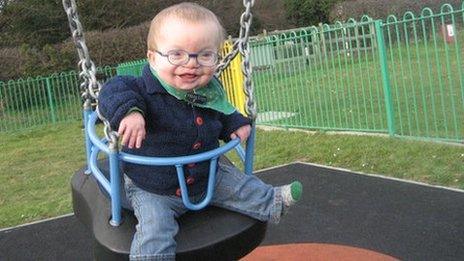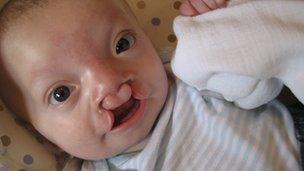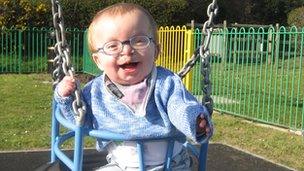Cleft condition can have long-lasting effects
- Published

Thomas had his first operation on his cleft lip at five months old
Jade is looking forward to her tenth operation in May. This time it's a nose job.
"I want it really badly. I can't wait," say the 16-year-old from West Yorkshire.
"I think it will make me more confident, although I'm quite confident already."
Jade was born prematurely with a unilateral cleft lip and palate. She weighed just two pounds at birth.
"We didn't find out until she was born that she had a cleft," says Andrea, her mum.
"But it never bothered us at all because we knew it could be operated on. Her size was more of a shock at the time."
Jade had her first operation at seven months old, to close the opening in the upper lip between the mouth and nose.
There have been subsequent operations to fix the palate (the opening in the roof of the mouth), to remove teeth, to prepare for a bone graft, to strengthen the jaw and other orthodontics work.
Yet, despite all that, she is still bright and bubbly, her mum says.
But there have been difficult moments.
"The worst bit was in Year 9, when some people thought I was different and they used to tease me," Jade says.
Failure to fuse
Cleft lips and palates affect around one in 700 babies born in the UK.
They are one of the most common birth defects in the UK, occurring when separate parts of the face do not join together properly when a baby is developing in the womb.
But, in many cases, the cause of this failure of the face to fuse is unknown.
It may be the result of a combination of genetic and environmental factors or just a 'one off' occurrence within a family.
In both situations, there is no way of predicting or preventing the condition in advance.
That's whythe world's largest research databank for cleft lip and palate was set upin the UK recently to determine what causes these common conditions.

Thomas was born with a bilateral cleft and palate
By asking parents of babies with these conditions to enrol in the five-year programme, theCleft Collective, externalteam hope to gather and analyse the DNA of the children to see if they can pin down a cause.
The project aims to follow these 3,000 or more children throughout their childhood in the hope of working out the best course of treatment and the best surgery options for future generations.
'Gappy smile'
This is good news for babies like Thomas Pennington, who has already had two operations to correct the bilateral cleft lip and palate he was born with ten months ago.
Two more operations are scheduled in the next year.
"We've been told it's a big hole," says his mum, Tamsin, who found out about his condition at the 20-week scan.
"It is massive, but it's symmetrical. We got used to it quickly and don't notice it at all now."
After the first operation on his cleft lip, there was a big change to Thomas's appearance.
"He still had a big smile, but it wasn't the huge gappy smile we were used to."
The second operation gave him a proper top lip and his nose has become more 'nose-shaped', changing his appearance yet again.
But the biggest challenge has been feeding Thomas, who is unable to suck.
Tamsin has used special bottles to squeeze milk into his mouth and only when his soft and hard palate are joined together will he be able to eat solid food.
She is acutely aware that there will be difficult times ahead for her son, at primary school and in his teenage years, when other problems connected to his cleft may arise.

Thomas just a few days after his second operation on his cleft lip
Jonathan Sandy, professor of orthodontics at the University of Bristol who is in charge of the Cleft Collective project, says the information gathered by the database could help.
"Repairing a cleft is not the end of the problem. All children with repairs look good at two years old, but what about at 20?
"Sometimes the hearing is affected, or the bottom jaw grows too big or there are problems with speech or teeth. Even psychological problems. There are effects all the way through," Prof Sandy says.
"Different genes are responsible for clefting and we want to find out how they interact so that we can make life better for youngsters with this condition."
- Published12 July 2011
- Published28 March 2012
- Published31 May 2011
- Published5 May 2011